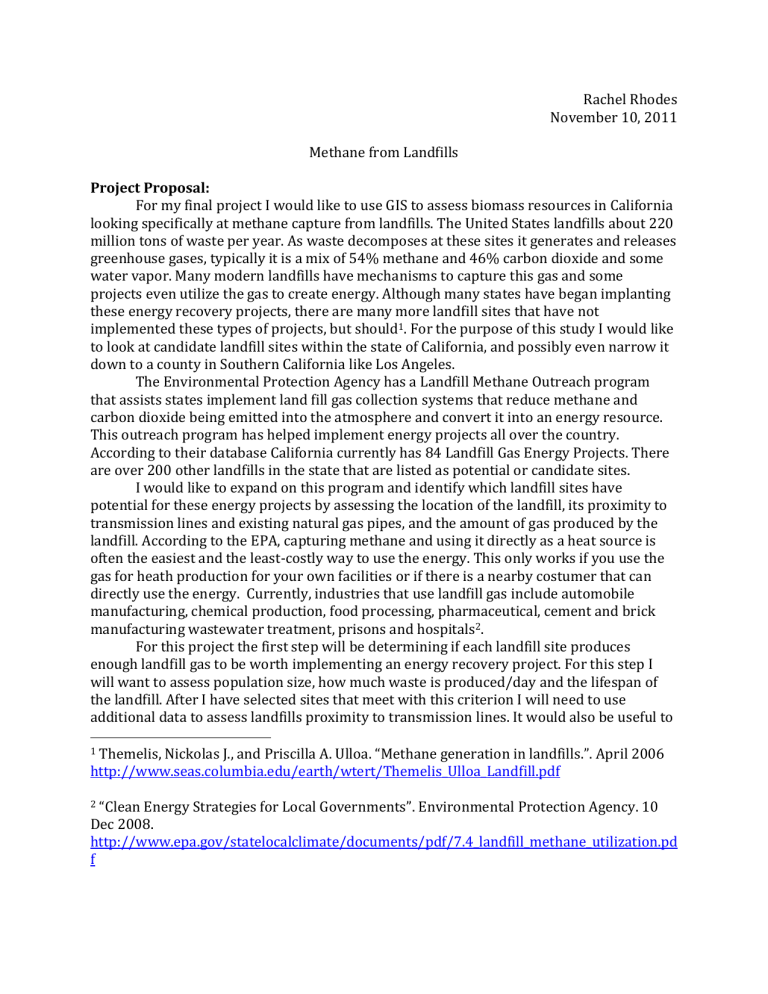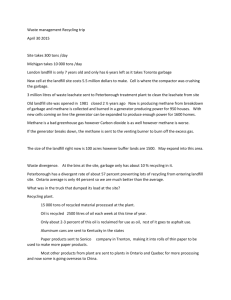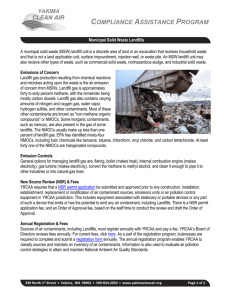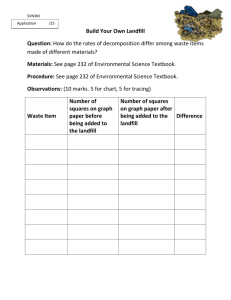Biomass_proposal

Rachel Rhodes
November 10, 2011
Methane from Landfills
Project Proposal:
For my final project I would like to use GIS to assess biomass resources in California looking specifically at methane capture from landfills. The United States landfills about 220 million tons of waste per year. As waste decomposes at these sites it generates and releases greenhouse gases, typically it is a mix of 54% methane and 46% carbon dioxide and some water vapor. Many modern landfills have mechanisms to capture this gas and some projects even utilize the gas to create energy. Although many states have began implanting these energy recovery projects, there are many more landfill sites that have not implemented these types of projects, but should 1 . For the purpose of this study I would like to look at candidate landfill sites within the state of California, and possibly even narrow it down to a county in Southern California like Los Angeles.
The Environmental Protection Agency has a Landfill Methane Outreach program that assists states implement land fill gas collection systems that reduce methane and carbon dioxide being emitted into the atmosphere and convert it into an energy resource.
This outreach program has helped implement energy projects all over the country.
According to their database California currently has 84 Landfill Gas Energy Projects. There are over 200 other landfills in the state that are listed as potential or candidate sites.
I would like to expand on this program and identify which landfill sites have potential for these energy projects by assessing the location of the landfill, its proximity to transmission lines and existing natural gas pipes, and the amount of gas produced by the landfill. According to the EPA, capturing methane and using it directly as a heat source is often the easiest and the least-costly way to use the energy. This only works if you use the gas for heath production for your own facilities or if there is a nearby costumer that can directly use the energy. Currently, industries that use landfill gas include automobile manufacturing, chemical production, food processing, pharmaceutical, cement and brick manufacturing wastewater treatment, prisons and hospitals 2 .
For this project the first step will be determining if each landfill site produces enough landfill gas to be worth implementing an energy recovery project. For this step I will want to assess population size, how much waste is produced/day and the lifespan of the landfill. After I have selected sites that meet with this criterion I will need to use additional data to assess landfills proximity to transmission lines. It would also be useful to
1 Themelis, Nickolas J., and Priscilla A. Ulloa. “Methane generation in landfills.”. April 2006 http://www.seas.columbia.edu/earth/wtert/Themelis_Ulloa_Landfill.pdf
f
2 “Clean Energy Strategies for Local Governments”. Environmental Protection Agency. 10
Dec 2008. http://www.epa.gov/statelocalclimate/documents/pdf/7.4_landfill_methane_utilization.pd
download data on potential costumers for direct (a few of which are listed about) who could directly-use landfill gas.
Data Layers needed:
County
Highways
Landfills, point data (EPA website)
Transmission lines
Amount of gas released at each landfill
Commercial users of LFG
Related Analysis:
The National Renewable Energy Laboratory (NREL) published a study conducted by
A. Milbrandt in 2006 called A Geographic Perspective on the Current Biomass
Resource Availability in the United States. The study assessed total biomass availability in the United States specifically looking at agriculture residues including biomass from crop residues, methane from manure, methane from land fills, forest residues, primary mill, secondary mill, urban wood, methane from domestic wastewater and switch grass on CRP lands. They used GIS maps to represent tons of biomass by county and tons of biomass per square kilometer by county for the entire country 3 .
In ESRI’s January 2010 guide to GIS Best Practices: GIS for Renewable Energy, they include research by the California Biomass Collaborative that assessed the economic feasibility of using biomass for energy in the future. The researchers used GIS to show where feedstock supply zones are and their proximity to biomass facility sites.
They assessed the economic feasibility by taking into consideration costs of feedstock type, transportation distance and the different road types 4 .
Global Energy Concepts, LLC produced a report in December 2006 for the State of
Hawaii Department of Land and Natural Resources and the Department of Business,
Economic Development and Tourism called “A Catalog of Potential Sites for
Renewable Energy in Hawaii”. This report used GIS data to assess sites for wind, solar thermal, photovoltaic, biomass, biofuels, biogas, geothermal, hydroelectricity, ocean wave and ocean thermal energy conversion. The report included a section on
3 Milbrandt, A. “A Geographic Perspective on the Current Biomass Resource Availability in the United States”. National Renewable Energy Laboratory. December 2005 < http://www.nrel.gov/docs/fy06osti/39181.pdf>
4 “GIS Best Practices: GIS for Renewable Energy.” Esri. January 2010
< http://www.esri.com/library/bestpractices/renewable-energy.pdf
>
the use of municipal solid waste to be used in waste-to-energy-processing facilities.
The report included GIS generated maps that displayed processing facilities for biomass food and agriculture waste and fat/oil/grease waste transfer stations. The report also identifies potential sites for municipal solid waste or landfill gas plants, selecting sites that are near existing landfills and taking into consideration the amount of dry tons of organic waste per year or per day 5 .
Another study conducted by Nickolas J. Themelis and Priscilla A. Ulloa from the
Earth Engineering Center and Department of Earth and Environmental Engineering at Columbia University assessed methane gas capture and its current use across the
United States. Although this study did not use GIS it gave excellent background information about the different types of landfills, the composition of biomass materials and the chemistry behind anaerobic biodegradation in landfills. The study goes on to talk about how landfill gas is utilized in the U.S. and which states have the most landfill gas utilization projects 6 .
5 “A Catalog of Potential Sites for Renewable Energy in Hawaii.” Global Energy Concepts,
LLC. December 2006.
< https://www.eerepmc.energy.gov/states/Hawaii_Docs/cpsre07.pdf
>
6 Themelis, Nickolas J., and Priscilla A. Ulloa. “Methane generation in landfills.”. April 2006 http://www.seas.columbia.edu/earth/wtert/Themelis_Ulloa_Landfill.pdf







![Job Description [DOCX - 46 KB]](http://s3.studylib.net/store/data/006796150_1-234d988c32268468d66802e573122cf6-300x300.png)

